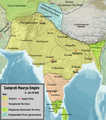चित्र:Samprati Maurya Empire.png

मूल फाइल (६५९ × ७४६ पिक्सेलहरू, फाइल आकार: ६५३ किलोबाइटहरू, MIME प्रकार: image/png)
| यो विकिमीडिया कमन्सको चित्र हो। त्यहाँ यसको विवरण पृष्ठबाट जानकारी तल देखाइएको छ। कमन्स स्वतन्त्र रूपमा इजाजतपत्र प्राप्त चित्र भण्डार हो। तपाईंले मद्दत गर्न सक्नुहुन्छ। |
सारांश
| वर्णनSamprati Maurya Empire.png |
English: Samprati Maurya Empire
Smith, Vincent Arthur; Edwardes, S. M. (Stephen Meredyth) (1924). The early history of India : from 600 B.C. to the Muhammadan conquest, including the invasion of Alexander the Great. Robarts - University of Toronto. Oxford : Clarendon Press.
Asiatic Society (Calcutta, India) (1832). Journal of the Asiatic Society of Bengal. Missouri Botanical Garden. Calcutta : Asiatic Society
Beni Madhab Barua (1946). Asoka And His Inscriptionns
The Cambridge History Of India Vol.I by E. J. Rapson.
An archaeological history of religions of Indian Asia by Jack Finegan.
The Archeology of World Religions by Jack Finegan.
|
| मिति | |
| स्रोत | मेरो आफ्नै कार्य and map created from DEMIS Mapserver, which are public domain. |
| लेखक | Levakpitam |
अनुज्ञा प्राप्त गर्दै
| This file is made available under the Creative Commons CC0 1.0 Universal Public Domain Dedication. | |
| The person who associated a work with this deed has dedicated the work to the public domain by waiving all of their rights to the work worldwide under copyright law, including all related and neighboring rights, to the extent allowed by law. You can copy, modify, distribute and perform the work, even for commercial purposes, all without asking permission.
http://creativecommons.org/publicdomain/zero/1.0/deed.enCC0Creative Commons Zero, Public Domain Dedicationfalsefalse |
References
- ↑ Smith, Vincent Arthur; Robarts - University of Toronto (१९२४) The early history of India : from 600 B.C. to the Muhammadan conquest, including the invasion of Alexander the Great, Oxford : Clarendon Press, p. 202
- ↑ Smith, Vincent Arthur; Robarts - University of Toronto (१९२४) The early history of India : from 600 B.C. to the Muhammadan conquest, including the invasion of Alexander the Great, Oxford : Clarendon Press, p. 458
- ↑ Asiatic Society (Calcutta, India); Missouri Botanical Garden (१८३२) Journal of the Asiatic Society of Bengal., Calcutta : Asiatic Society,
- ↑ Beni Madhab Barua (१९४६) Asoka And His Inscriptionns, p. 58
- ↑ Rapson, E. J. (१९३५) The Cambridge History Of India Vol.i, p. 512
- ↑ Finegan, Jack; Internet Archive (१९८९) An archaeological history of religions of Indian Asia, New York : Paragon House, p. 115 ISBN: 978-0-913729-43-4.
- ↑ Finegan, Jack; Internet Archive (१९५२) The Archeology of World Religions, p. 219
- ↑ Sharma, S. r (१९४०) Jainism And Karnataka Culture, p. 130
Captions
some value
copyright status अङ्ग्रेजी
copyright license अङ्ग्रेजी
Creative Commons CC0 License अङ्ग्रेजी
source of file अङ्ग्रेजी
original creation by uploader अङ्ग्रेजी
८ डिसेम्बर 2023
media type अङ्ग्रेजी
image/png
फाइल इतिहास
मिति/समय मा क्लिक गरेर त्यससमयमा यो फाइल कस्तो थियो भनेर हेर्न सकिन्छ ।
| मिति/समय | छोटो चित्र | आकारहरू | प्रयोगकर्ता | टिप्पणी | |
|---|---|---|---|---|---|
| हालको | ०६:०४, १९ मे २०२४ |  | ६५९×७४६ (६५३ किलोबाइटहरू) | Levakpitam | minor correction |
| ०५:०१, ९ डिसेम्बर २०२३ |  | ६५९×७४६ (६५४ किलोबाइटहरू) | Levakpitam | Uploaded own work with UploadWizard |
फाइल प्रयोग
यस फाइलमा निम्न पृष्ठ जोडिन्छ:
विश्वव्यापी फाइल प्रयोग
निम्न अन्य विकिहरूमा यस फाइलको प्रयोग:
- en.wikipedia.org मा उपयोग
- hi.wikipedia.org मा उपयोग
- simple.wikipedia.org मा उपयोग
मेटाडाटा
यस फाइलमा अतिरिक्त जानकारीहरू छन्, यसलाई बनाउन सम्भवतः डिजिटल क्यामरा अथवा स्क्यानर प्रयोग गरिएको हुनुपर्छ । यदि यस फाइललाई मूल अवस्थाबाट परिवर्तन गरिएको हो भने यस फाइलले सम्पूर्ण विवरण प्रतिबिम्बित गर्न सक्नेछैन ।
| क्षैतिज संकल्प(resolution) | ३७.७९ प्रतिसेन्टिमिटरथोप्लाहरु(डिपिसी) |
|---|---|
| ऊर्ध्वाधर संकल्प(resolution) | ३७.७९ प्रतिसेन्टिमिटरथोप्लाहरु(डिपिसी) |
"https://ne.wikipedia.org/wiki/चित्र:Samprati_Maurya_Empire.png" बाट अनुप्रेषित